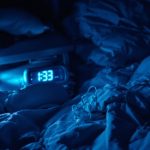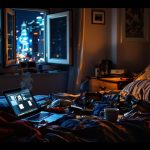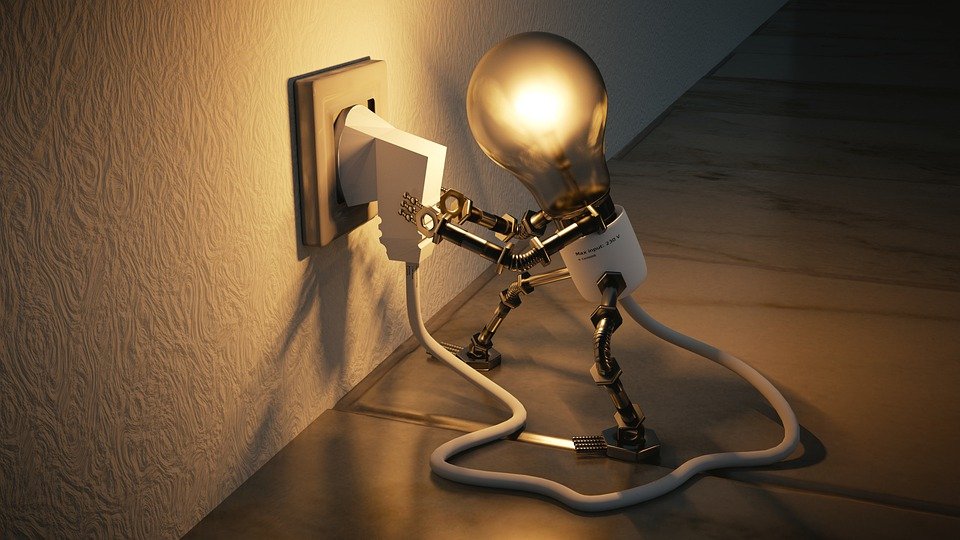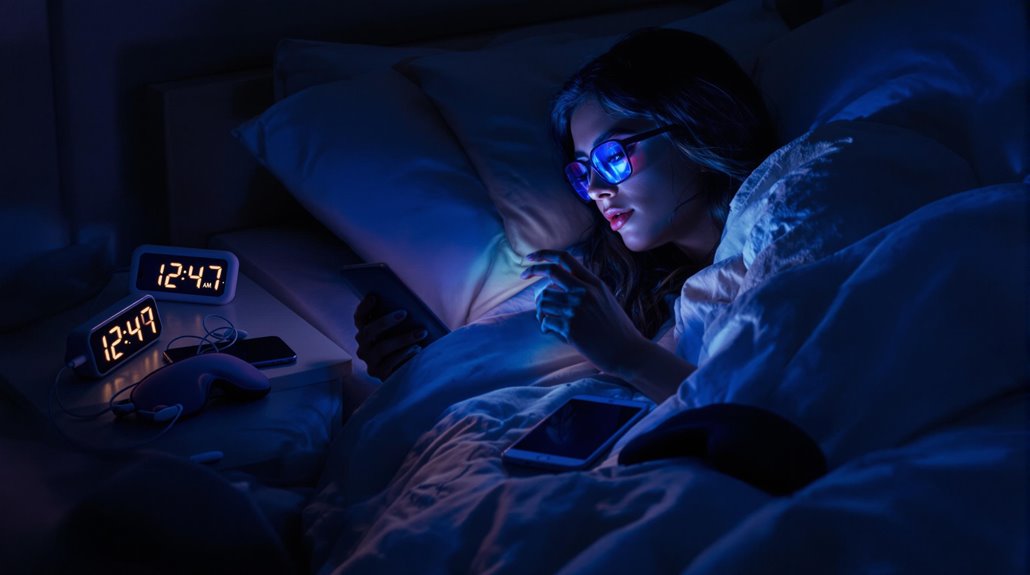
Technology shapes your sleep hygiene in several ways. The blue light from screens can suppress melatonin, making it harder to fall asleep. Engaging with technology before bed overstimulates your mind, increasing heart rate and adrenaline levels, which disrupts sleep. Children face even more challenges with inconsistent bedtimes and environmental factors affecting their rest. To improve sleep hygiene, set boundaries by turning off devices 30-60 minutes before bed and charging them outside your bedroom. Modern innovations like smart sleep headbands and watches provide insights and therapeutic interventions. Explore how these elements intertwine with your nightly routine for restful sleep.
Blue Light’s Role in Sleep
Blue Light’s Role in Sleep
While you mightn’t notice it, blue light plays a significant role in your sleep patterns. It’s there in the glow of smartphones, tablets, televisions, and even the LED bulbs illuminating your room after sundown. You might think you’re simply catching up on the latest series or scrolling through social media, but these activities come at the expense of your melatonin levels. Exposure to blue light sources often combines with caffeine consumption to jointly delay your sleep onset and compromise overall sleep quality.
Blue light, particularly in the 400 to 490 nanometer range, suppresses melatonin secretion, tricking your brain into believing it’s still daytime. As a result, your natural sleep-wake cycle is thrown off, leading to restless nights and sluggish mornings. Disrupting your circadian rhythm with blue light can lead to potential health risks such as heart disease and cancer.
Your instinct for liberation and breaking free from unnecessary restrictions is powerful. It’s time to apply that drive to your evening habits. Be aware that chronic exposure to blue light, even in dim settings, can misalign your circadian rhythms, keeping you in a cycle of sleep disruption.
The Overstimulation Dilemma
Interactive technology is a double-edged sword for your bedtime routine. While it offers exciting avenues for active engagement, it also triggers mental stimulation that can disrupt your sleep. Actively using bedtime technology—like playing games or texting—increases your heart rate and winds up your brain. This mental stimulation leads to adrenaline surges, creating a cycle of sleep disruption. Such habits accidentally carve into precious sleep time, making it harder for you to unwind. Engaging with nighttime technology like screens can also influence hunger regulation as insufficient sleep has been linked to increased appetite. Using technology in the bedroom, such as engaging with screens right before bed, is linked with sleep loss due to blue light exposure. Before bed, the allure of interactive digital activities is strong, but it comes with stressful consequences. Engaging with exciting or violent content raises your alertness level, seriously impairing your ability to drift into sleep. Your brain remains too stimulated, delaying your shift to dreamland, and carving out a restless night that leaves you weary in the morning.
Children’s Sleep Challenges
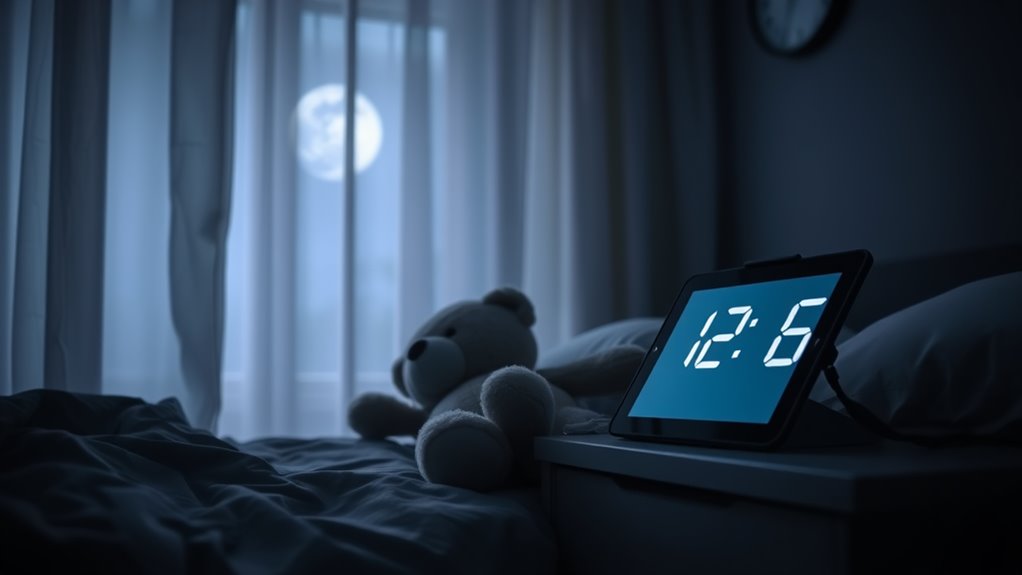
Childhood sleep challenges are often overlooked but have profound implications on health and development. You may not realize that nearly 37.5% of children aged 6-12 aren’t getting enough sleep. This lack of rest is more severe in non-Hispanic Black children and those from low-income households, where short sleep affects about 50% and 44.9% of these young ones, reflecting a striking connection to socioeconomic status.
The neighborhood you live in has a significant impact on your child’s sleep. Unsafe environments, lack of support, and poor conditions increase the likelihood of sleep deprivation. Consider these factors:
- Environmental Stress: Unstable neighborhood conditions can disrupt a child’s sleep hygiene.
- Pandemic Effects: Lockdown and a lack of activities have contributed to widespread sleep disturbances.
- Parental Influence: Inconsistent bedtime routines affect 57.3% of children, leading to shorter sleep durations.
Regular physical activity can play a crucial role in promoting better sleep, as it helps reduce stress and improve overall physical health. Your parental influence is vital. Poor mental or physical health and stress can unknowingly transfer to your kids, disrupting their sleep.
Understand that insufficient sleep is linked to mental and physical health issues, like obesity and developmental disorders. Embracing mindful habits and creating a supportive environment can liberate your child from these sleep challenges.
Managing Devices for Rest
The glow of screens is a familiar nighttime companion, yet it can quietly sabotage your sleep. Screen time before bed can make it harder to drift off and diminish the quality of your rest. Bright screens hinder melatonin release, keeping your mind alert when it should be unwinding. To reclaim your nights, establishing device boundaries is key. A simple act of turning off electronics 30-60 minutes before bed can help. Consider creating a charging station outside the bedroom, reducing the temptation to check notifications. Design your sleep environment as a sanctuary, free from digital intrusions. A “no screen” policy near bedtime enforces a clear boundary, ensuring your bed remains a haven solely for rest. If you must use devices, opt for passive pursuits like reading, which is less disruptive. Apps like f.lux can filter blue light, supporting a smoother shift to slumber. To enhance your sleep further, incorporating soothing sounds such as white noise can mask background disturbances, creating an optimal environment for rest.
Sleep Tech Innovations
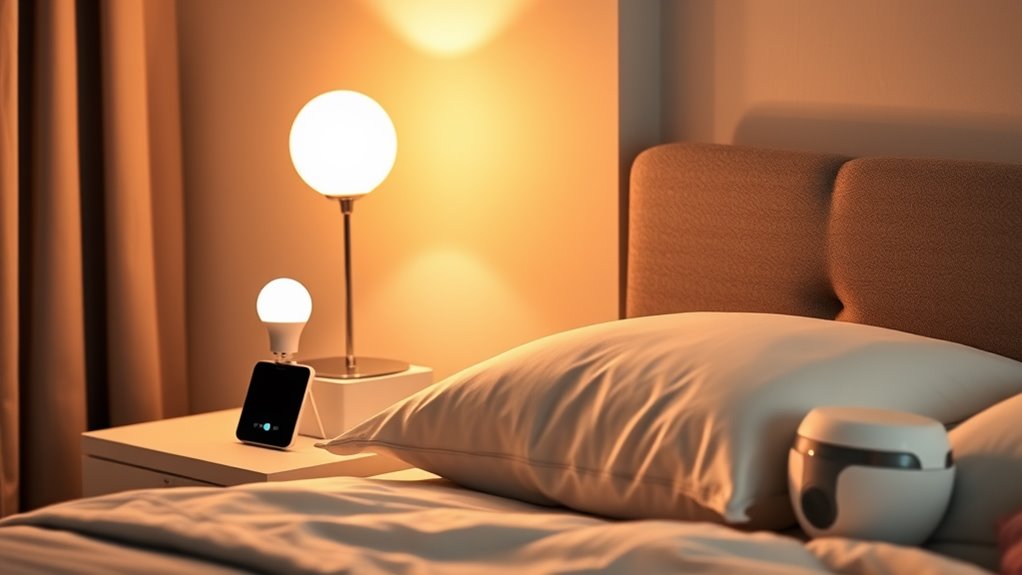
Embracing technology in your sleep routine doesn’t always mean more screen time before bed. Innovative devices are reimagining sleep in ways that promote liberation from the constraints of restless nights.
Technologies like Somnee’s smart sleep headband leverage advanced neuromodulation to enhance sleep quality without fuss, reducing your time to slumber by half. Samsung’s Galaxy Watch Ultra equips you with FDA-approved tools for sleep tracking, including sleep apnea detection and tailored coaching, turning sleep insights into actionable strategies.
Consider these pioneering innovations:
- Smart Sleepwear and Accessories: Somnee’s headband and wearable devices like the Galaxy Watch Ultra wrap you in comfort with their non-invasive functionality, propelling you toward deeper, more restorative sleep.
- AI-Driven Insights: AI models, such as EnsoData’s, shed light on personal sleep patterns and provide predictive sleep solutions. These technologies use data trends and recommendations to empower you with the ability to personalize and enhance your own sleep hygiene.
- Advanced Therapeutic Tools: Devices using electrical vestibular nerve stimulation treat chronic insomnia innovatively. They remove barriers to better sleep without drugs or complex installations.
Incorporating mindfulness meditation into nightly routines can further enhance sleep quality, as it reduces overthinking and promotes relaxation.
With these advancements, liberation from poor sleep is within your grasp, turning your nights into a sanctuary of rest.

